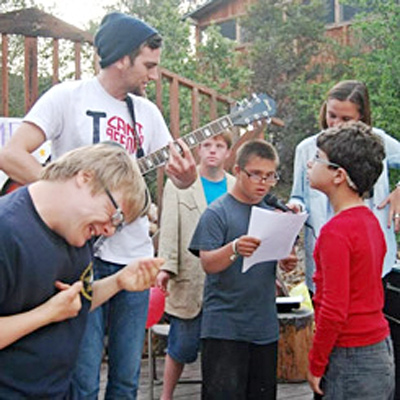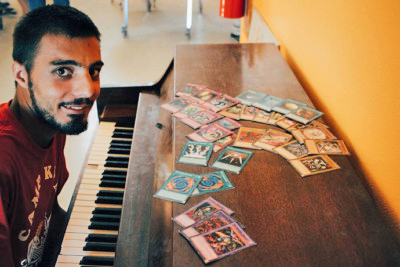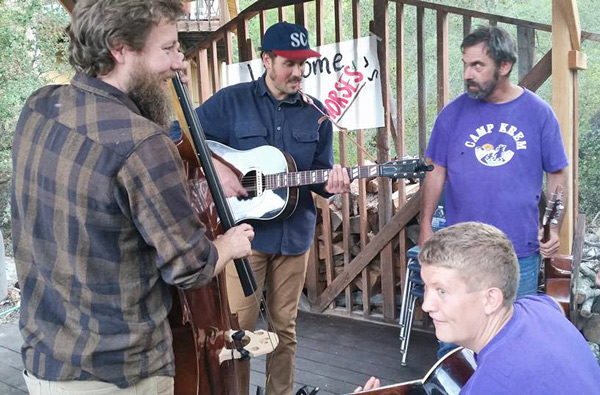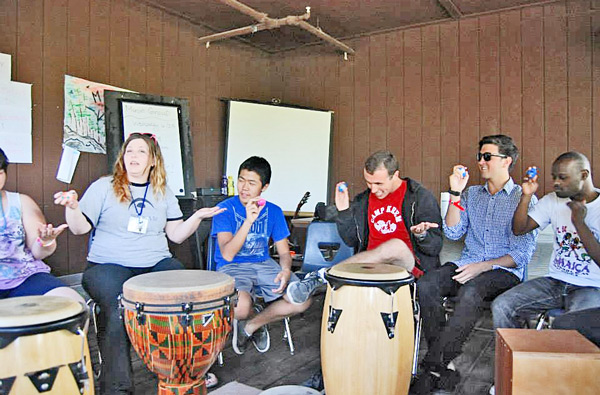Music and music therapy are fundamental parts of our program. There is “significant evidence supporting the value of music therapy in promoting social, emotional and motivational development in children with autism.”1, 2, 3 Tuned in to Learning, a San Diego based music therapy organization specializing in special education,4 lists the benefits of music-assisted learning to include:
- Music is an effective task motivator for many students, decreasing non-compliant behavior during initial instruction and providing a means for increased attention and duration of on-task participation.
- Music functions as a mnemonic aid, assisting students in foundational learning and retention of academic facts, social & communication scripts, and task sequences.
- Similar to the use of visual supports, music cuing provides a means to structure auditory stimuli and speech output for students with cognitive or language delays.
- Music provides concurrent auditory and kinesthetic learning opportunities for students with multiple disabilities, severe orthopedic impairments, or students with visual impairments.
- Music is a successful inclusion tool, engaging special learners and typical peers together in an environment that is meaningful to all participants.

For people living with developmental disabilities, Autism Spectrum Disorder or other related disorder, music therapy can help with:
- Increases focus, or sustained attention;
- Decreases pain perception;
- Opportunity for expression of feelings or decision making;
- Increase of communication and speech needs;
- Focuses on social skills such as eye contact, appropriate touching, personal space, overall group cohesion and interpersonal relationships;
- Opportunity to isolate and exercise upper and/or lower extremities, based on need;
- Promotes overall wellness;
- Provides sense of empowerment and encouragement you may not find elsewhere.

There is strong evidence that individuals with autism can better learn or enhance individual skills such as counting, learning colors, taking turns, learning the feelings of others when these are first presented through music, song or other rhythmic cueing,5 and that long term music therapy has been effective in achieving established objectives in virtually all cases.6 “Music influences human behavior by affecting the brain and subsequently other bodily structures in ways that are observable, identifiable, measurable, and predictable, thereby providing the necessary foundation for therapeutic applications.”7
Music therapy interventions can be designed to promote wellness, manage stress, alleviate pain, improve communication, enhance memory, help deal with stress, and progress physical rehabilitation. It can include anything from listening to music to playing an instrument. This can include anything from listening to music, singing, playing an instrument to dancing and has been specifically established to help children with disabilities. “Music therapy has undeniable results when dealing with children who have disabilities. Children who have social issues, and have trouble making friends have also been known to benefit wildly from music therapy.” 8
“Everyone in the world relates to music. It is the universal language and has the power to communicate with those that communication seems impossible.”9 “We know that music therapy treatment is associated with improvement” in children with autism, reports Catherine Lord, a professor of psychology at the University of Michigan specializing in autism research.10 “A 2009 study showed that during play sessions with music, children with autism were more socially engaged with their peers than in sessions without music. Music encouraged the children with autism to interact in more appropriate ways with other children, including sharing and taking turns” 11 “Music is one area of stimulus that almost all autistic children positively respond to, like and enjoy. In fact, they respond more positively to music than any other auditory stimulus, and many autistic children demonstrate better music skills than cognitive skills!”12 Even more exciting, Australian researcher Allan Snyder goes one step further, arguing that many individuals on the autism spectrum may be “savants” who can access creative genius freely, and that music may be a avenue to this discovery.13, 14
The revolutionary and controversial work of French medical doctor Alfred A. Tomatis, who treated a variety of conditions, including autism 15, 16, 17, 18, supports the benefits of listening and of music therapy.19, 20
Tim Ringgold, a music therapist, observes that we are all “rhythmic beings”, that music echos the rhythms of our own bodies and thereby creates instant bonds between people sharing the same music, in a way that avoids the many social obstacles that prevent effective communications and connection. 21
Our wonderful music program was originally funded in 2013 by the generosity of the Marcia and John Goldman Foundation https://jmgoldmanfoundation.org/ and developed by Professor Petra Kern, Ph.D., MT-DMtG, MT-BC, MTA (www.musictherapy.biz), who is Past President, World Federation of Music Therapy, Editor, imagine Early Childhood Online Magazine, Adjunct Professor of Music Therapy, Marylhurst University and Adjunct Associate Professor, University of Louisville and two of her students. It was implemented successfully in the Summer of 2013 by one of them. Each summer since, we have had one or two music therapy students or graduate certified music therapists managing our music program, with great success.
Best practices, gleaned from our own success and review of work by others have been adopted, including the findings of the National Autism Center’s National Standards Report22, as well as scholarly work by Matson23, Lovaas24, Fox25 and others.


Resources
1 Kim, Jinah, Wigram, Tony, Gold, Christian, “Emotional, motivational and interpersonal responsiveness of children with autism in improvisational music therapy”, SAGE Publications and The National Autistic Society, Vol 13(4) pp 389–409 Read here
2 Rudy, Lisa Jo, Autistic Children and Music Therapy Benefits | verywellhealth.com
3 Kaplan, Ronna, Music Therapy for Individuals With Autism | HuffPost Life
4 Music Therapy Special Education Songs | Coast Music Therapy
5 American Music Therapy Association, Fact Sheet ASD and MT | musictherapy.org
6 Kaplan R.S., Steele A.L., “An analysis of music therapy program goals and outcomes for clients with diagnoses on the autism spectrum”, Journal of Music Therapy, Vol 42 Number 1, pp 2-19 (2005), read abstract here “All formats were successful when addressing initial objectives, with lesson-based format being most effective in reaching intermediate objectives. Lastly, 100% of parents and caregivers surveyed indicated subjects generalized skills/responses acquired in music therapy to non-music therapy environments.”
7 Center for Music Therapy
8 American Music Therapy Association
9 Goodman , Jennifer Pacht, “Jammin Jenn Music Therapy for Children”, Read here
10 Hwang, Jean, Evidence Is Slim, but Experts Say Music Therapy Is Valuable in Addressing Autism | washingtonpost.com
11 Music and Autism: The Benefits of Music for Special Needs Children | takelessons.com
12 Music and Autism: Here are Amazing Ways Music Helps | goodparentingbrighterchildren.com
13 Hughes, James E A, Savant syndrome has a distinct psychological profile in autism | biomedcentral.com
14 Snyder, Allan, “Artistic Genius, Nature, April 2004, Read here
15 Autism Speaks, More here
16 Tomatis Method | Music Based Therapy for Auditory Processing Disorders and more
17 Sollier, Pierre M.F.C.C. Director, The Mozart Center in Lafayette, CA, Read here, “About 60% of autistic children seem to respond positively to [the Tomatis Method].”
18 Mack, Marsh, Research On Tomatis Method | atotalapproach.com
19 Read more here. Although his work is certainly controversial, some of those treated by him (including Gérard Depardieu, Sting and Maria Callas) claim highly beneficial results from him and his method.
20 Watch here and read here
21 National Autism Center, National Standards Report, (2009) “addressing the need for evidence-based practice guidelines for autism spectrum disorders”, it was here
22 Matson, Johnny L, “Determining treatment outcome in early intervention programs for autism spectrum disorders: A critical analysis of measurement issues in learning based interventions” Research in Developmental Disabilities, Volume 28, Issue 2, March–April 2007, Pages 207-218, read here
23 Lovaas, O. Ivar, Smith, Tristram, “A comprehensive behavioral theory of autistic children: Paradigm for research and treatment”, Journal of Behavior Therapy and Experimental Psychiatry, Volume 20, Issue 1, , Pages 17–29 University of California, Los Angeles, USA (March 1989), read here. From abstract: “The behavioral theory derived from such work has four tenets: (a) autistic children’s behaviors are consistent with laws of learning derived from the behavior of other organisms; (b) autistic children have many separate behavioral difficulties best described as a developmental delay; (c) despite their difficulties, many autistic children learn as much as other human beings in certain environments; and (d) their difficulties can be viewed as a mismatch between a deviant nervous system and average or typical environments rather than as a disease.”
24 Foxx, Richard M., “Applied Behavior Analysis Treatment of Autism: The State of the Art”, Child and Adolescent Psychiatric Clinics of North America, Volume 17, Issue 4, Pages 821–834 (October 2008), read here.

